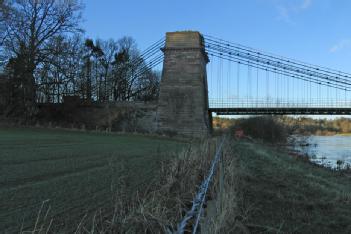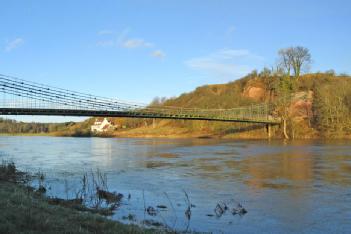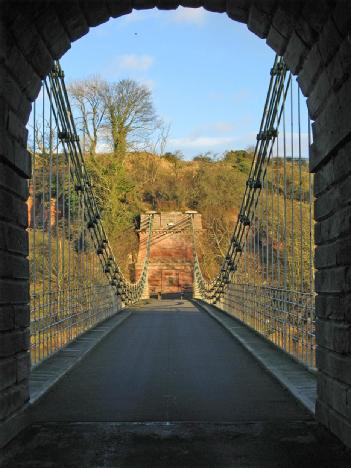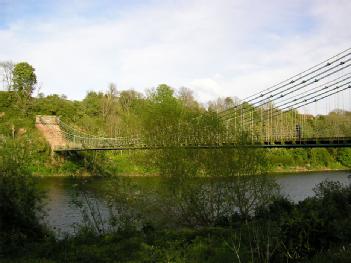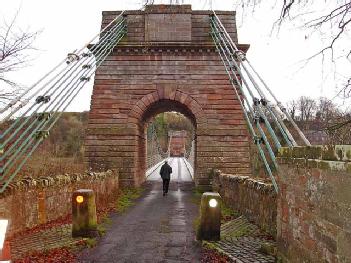
Union Bridge (Tweed) |
TD15 1XQ Berwick-upon-Tweed, Great Britain (UK) (Scotland) |
|
| Address |
between Horncliffe & Fishwick
|
| Floor area | unfortunately not known yet |
|
Opening times
|
|
|
Status from 01/2017
|
Free entry. |
| Contact | Unknown contact data for this museum - please help via contact form. |
| Homepage | |
| Location / Directions |
Horncliffe is a village in the county of Northumberland, England. It lies on the south bank of the River Tweed about 5 miles (8 km) south west of Berwick-upon-Tweed, and about 3 miles (5 km) north east of Norham and is the most northerly village in England. Perryman's Buses route 67 provides a number of services a day each way to/from Berwick-upon-Tweed railway station. Fishwick is a small medieval village and farm in the Scottish Borders, in the traditional county of Berwickshire. It is just north of the River Tweed which here constitutes the border with England. Union Bridge lies on Sustrans Route 1 and the Pennine Cycleway. |
| Description | From Wikipedia, the free encyclopedia: Although work started on the Menai Suspension Bridge first, the Union Bridge was completed earlier. Today it is the oldest suspension bridge still carrying road traffic. History 1820 painting of the bridge by Alexander Nasmyth Detail of the bridge, with a rose and thistle entwined and the motto Vis Unita Fortior (Latin: "United, Strength is Yet Stronger") Before the opening of the Union Bridge, crossing the river at this point involved an 11-mile (18 km) round trip via Berwick-upon-Tweed downstream or a 20-mile (32 km) trip via Coldstream upstream. (Ladykirk and Norham Bridge did not open until 1888.) Construction The bridge was designed by an English Royal Navy officer, Captain Samuel Brown. Brown joined the Navy in 1795, and seeing the need for an improvement on the hemp ropes used, which frequently failed with resulting loss to shipping, he employed blacksmiths to create experimental wrought iron chains. The HMS Penelope was fitted with iron rigging in 1806, and in a test voyage proved successful enough that in 1808, with his cousin Samuel Lenox, he set up a company that would become Brown Lenox & Co.Brown left the Navy in 1812, and in 1813 he built a prototype suspension bridge of 105 feet (32 m) span, using 296 stone (1,880 kg) of iron. It was sufficiently strong to support a carriage, and John Rennie and Thomas Telford reported favourably upon it. Brown took out a patent in 1816 for a method of manufacturing chains, followed by a patent titled Construction of a Bridge by the Formation and Uniting of its Component Parts in July 1817.In around 1817, Brown proposed a 1,000 feet (300 m) span bridge over the River Mersey at Runcorn, but this bridge was not built.[3] It is not known why Brown became involved with the Union Bridge project, but agreed to take on the work based on a specification dated September 1818. Brown knew little of masonry, and Rennie did this aspect of the work. The bridge proposal received consent in July 1819, with the authority of an Act of Parliament that had been passed in 1802, and construction began on 2 August 1819. It opened on 26 July the following year. Captain Brown tested the bridge in a curricle towing twelve carts, before a crowd of about 700 spectators crossed. Until 1885, tolls were charged for crossing the bridge; the toll cottage, being at the English end, was demolished in 1955. Design
The bridge has a single span of 449 feet (137 m).
It runs on an east-west alignment, with the eastern end in Scotland and the western end in England. At the Scottish end the road continues straight, but at the English end it turns sharply south. In December 2008 the bridge was closed to traffic as a result of a landslide. In March 2013 it was reported that the bridge was proposed to be closed because of a lack of funds to maintain it. In October 2014, it was reported that local enthusiasts and activists had started a campaign to have the bridge fully restored in time for its bicentenary in 2020. |
[dsp_museum_detail.cfm]
| Data Compliance | More Information |
